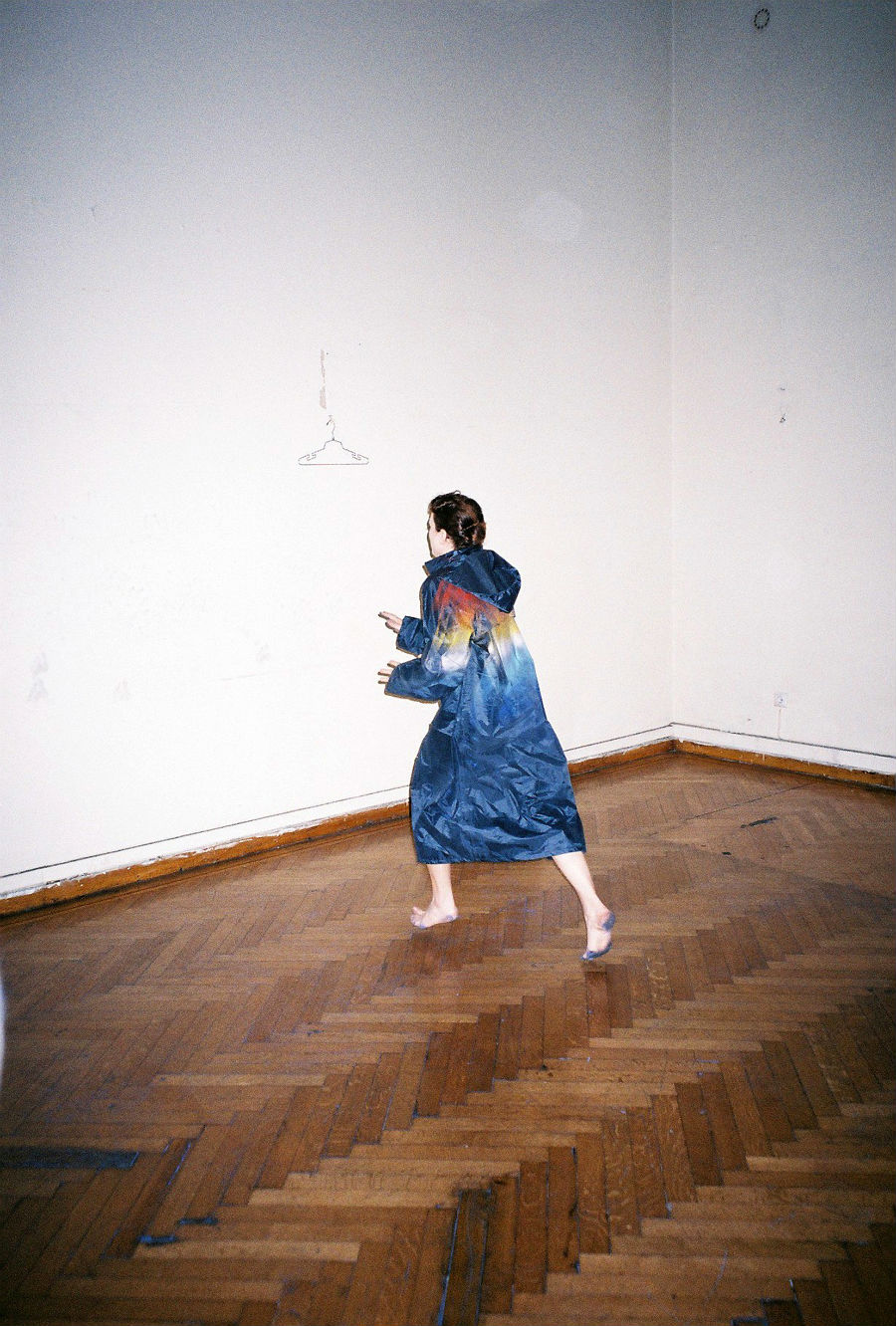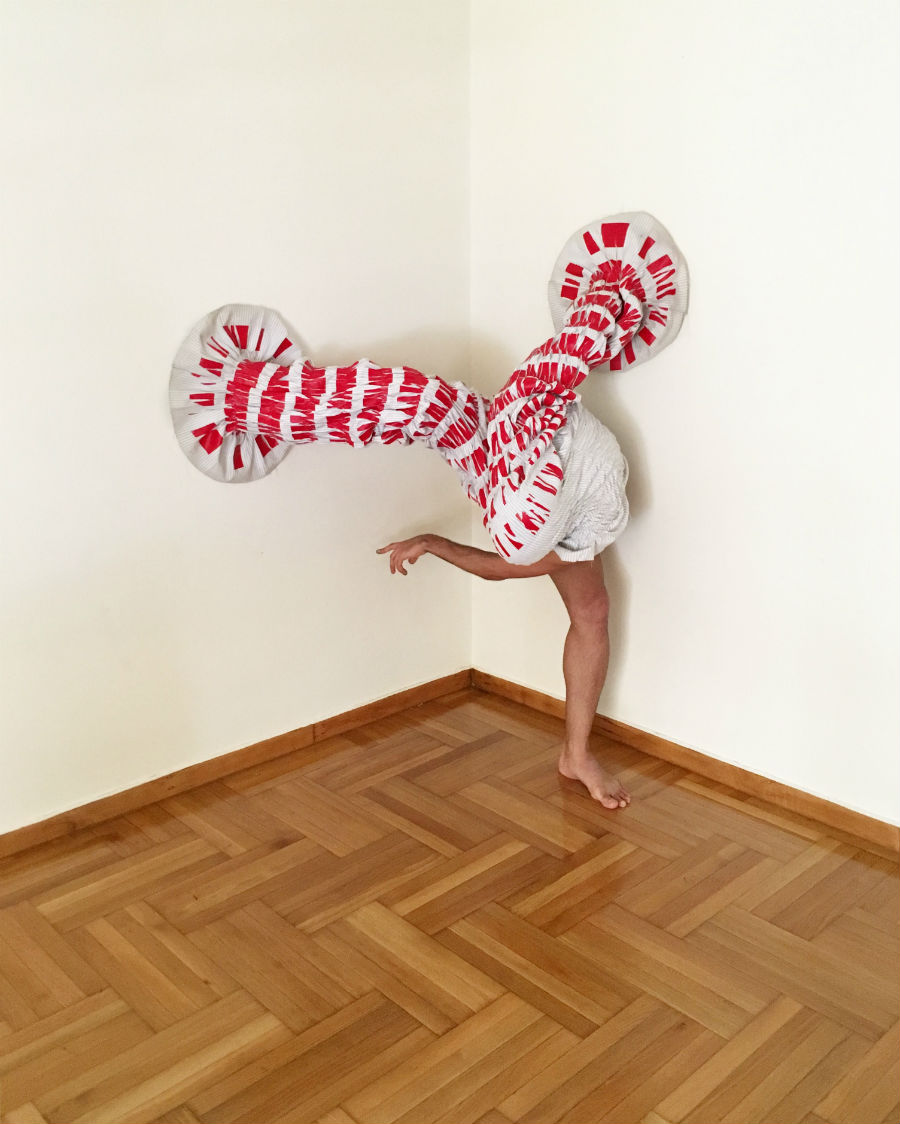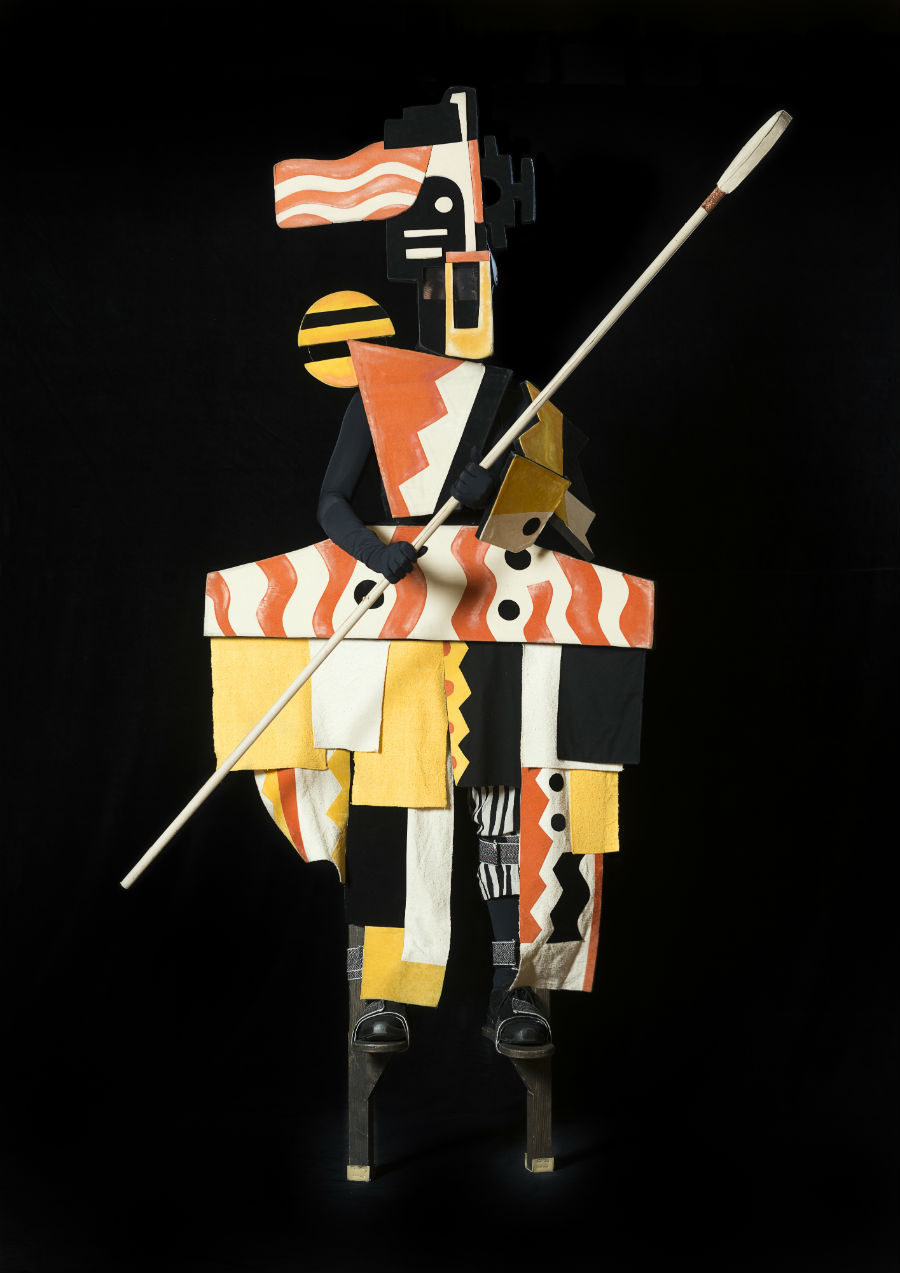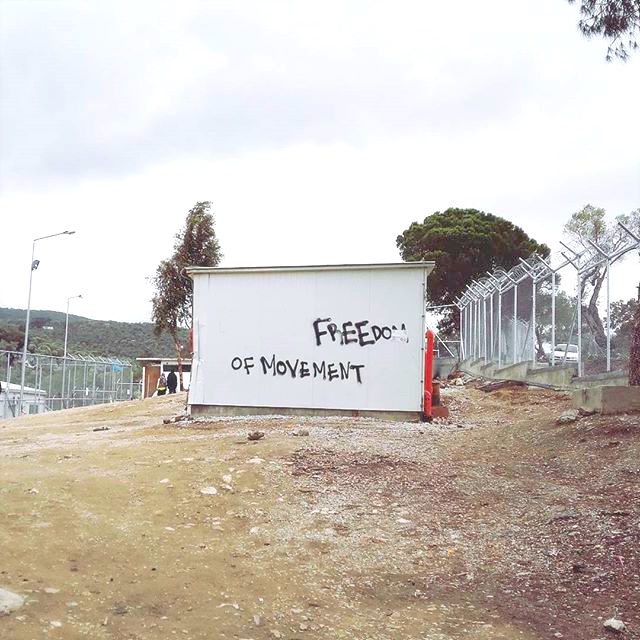Charismatic, eloquent, and a self-proclaimed romantic, Athina Delyannis is silently working to expand the Swiss cultural footprint in Athens in a win-win way for local artists. The French-taught cultural manager is running the Athenian satellite of Geneva-based Flux Laboratory, which was founded in 2003 as a platform for the promotion of dance and performance and since 2015 operates in Athens as well. Flux Laboratory produced the project Going Where we Came From in Kypseli last May, which we presented through an article. Athina is also the founder of Pallas projects, which she started as a way to engage with culture in the Mediterranean but is currently in hibernation until further notice. At the same time, Athina works with her husband Chris Kontos in publishing and distributing Kennedy, a biannual magazine of which we are devout fans. We met with Athina on the mezzanine of Heteroclito wine bar near Syntagma, to discuss her involvement in the recent staging of La Création du Monde—the revival of a 1920’s French ballet with music by Darius Milhaud and incredible costumes—in Athens, to discover more about her connection to the city and learn about her upcoming projects.

What is Flux Laboratory and what is your role in it?
I started working with Flux Laboratory in Geneva, but at some point I felt that Switzerland wasn’t for me. I also met my husband Chris around that time, so I quit my job there and I came back to Greece. I always wanted to return to Greece, just as anyone with a connection to this country wants to do when they’re abroad. So after I came back the director of Fluxum Foundation said that now that I’m in Athens we can do more things. So since 2015 we’re running some projects here. I should have said first that the foundation has two parts. We have Fluxum Foundation that was born in 2002 and its founder is Cynthia Odier, who is of Greek descent, and which has as its main mission to support dance and performance. It supports artists, companies, productions... But this is rather limiting, and Odier is a very artistic being with a lot of inspiration and ideas, she wanted this to be something bigger. So she founded Flux Laboratory in 2003 also in Geneva, and which is somewhat more experimental, at a time when this wasn’t the norm, especially in Switzerland. So she brought together art forms like design and dance, entrepreneurship with visual communication, with artists, with performers. She brought these worlds together, to help them try and communicate with each other in a new way. And she achieved that, it was very innovative in Switzerland, so it continued and adapted to the flow of the times so to speak. Today the Laboratory tries to bring forth projects that are connected to the visual arts and always adds a bit of dance inside, a bit of performance, so it’s a trans-disciplinary project above all.
The biggest part of what Flux Laboratory does is production, which means that whatever the Foundation supports, the Laboratory can produce. It also means that the Laboratory can support projects beyond dance and performance, and in that to reach out to another audience. As you can understand, these two bodies so to speak adapt to all occasions and in that way we have collaborated with artists and creative people in general: designers, musicians, people from the business sector, scientists and so on. We work with the École Polytechnique Fédérale de Lausanne, where we developed some projects that have to do with dance and science. For example we developed special captors that can be fixed to dancers’s shoes to study their movement; these can keep tracks and traces of movement, which as you know is very difficult to do in dance, to keep an archive. In Athens we began in 2015 with something very simple. We did a collaboration with Metamatic TAF and presented our archives, the history of Flux, the bigger recent projects we had done—like a big project we did with artist John Giorno, who was a friend of Warhol and is a seminal figure in voice poetry internationally. But the real starting point for us in Athens was an event we organised at EMST [National Museum of Contemporary Art] before it opened, with Swiss artist Denis Savary. The event was called LAGUNE and we collaborated with Greek dancers. That was the moment for me when I said that this is really how we want to work in Greece.
When was that?
That happened in May 2016 if I remember right. So that was the moment when we decided that we can bring foreign artists with foreign budgets, but we collaborate only with locals. Our activities have three strands so to speak. The first is artistic and has to do with dance and performance. We work closely with the dance schools of Markela Manoliadi and Dimitris Kaminaris, who are both great dancers and choreographers, and we are a main partner of KSOT [National School of Dance]. Then we have collaborations for social causes, like with refugee camps and NGOs, and we offer dance classes to little girls from these camps and NGOs based in Athens. So two days per week we offer free ballet classes to little ballerinas. And the third part is entrepreneurship, where we work closely with filmmaker Daphné Bengoa, and we create films that relate to entrepreneurship in Greece today and how people like you or craftspeople try to share a more positive image of Athens and Greece in general. So these are the three parts of what we do.
The main element in Fluxum Foundation and Flux Laboratory is that they’re very wide in scope and that makes it difficult for people to understand what we do. But we have decided that what we do should always be what the city needs. So when we began in 2015 the city needed collaborations, because in Greece and in Athens especially it’s very difficult to bring two institutions together to really work together and grow something together. We tried really hard.
Do you have an example of this kind of collaboration?
Yes, for example we did this recent performance at Athens Concert Hall with the Greek State Orchestra, the KSOT and the Swiss Embassy. At this point I should mention that the embassy supports us in every project we do, we are in a way the antenna of Swiss culture in Athens. Bringing institutions together to collaborate has its limitations, I mean it can only happen up to one point, and that point is always when the public sector gets involved. But we can see that in general there is the will, and we have done a lot from our part, but now we have decided to change things a bit, to adapt. Because when you don’t see things moving forward, you adapt. And when you realise that the energy in the city is changing, you too have to conform in a way. What we are doing now and I hope it will take shape soon, is that we found a space in Koukaki, which we want to turn into a centre for performance to be something like the headquarters of dance artists and dance-school graduates. Because there’s nothing like it in Athens, that offers the framework within which they can work legally, to be able to be insured by employers. It’s actually very difficult to do something as simple as a dance class and get people paid; every time we were scratching our heads to figure out how to pay these people because nobody declares anything. So we want to have a structure that enables that, and where people can come from abroad, without patronising them in how they should work but to offer a good work environment for these artists.
So is this going to be for performance in general or just for contemporary dance?
It’s going to be for both, because the dance world isn’t that big, the possibilities are limited. But we’re seeing this first and foremost as a home that welcomes artists. And because Athens is UNESCO’s World Capital of Book for 2018, we want to have some books that are going to be available there for people to read for free, people will be able to hang out there and read, come and work in the space as well, there will be room for activities. So it’s going to become a roof under which we can organise events, do performances around books and poetry, that sort of thing. I believe that it’s the artists who will give life to the space and define how it will work exactly, without us imposing anything. Because we often see that as an institution we focus on theoretical and conceptual things so much that we miss the point.

And how about La Création du Monde? How did that project come about? I understand that the first performance was in Switzerland some time ago?
Yes, it was in 2000, even before the Foundation was created. La Création du Monde was Mrs Odier’s first project, and was a collaboration between Millicent Hodson and Kenneth Archer, who are considered choreographers-archaeologists. They are indeed archaeologists, because they were looking for traces and signs from this 1923 choreography that was lost after it was staged. The sets were lost, the costumes were lost, all that was left was the drawings by the artist Fernand Léger and some posters from the premiere at the Théâtre des Champs-Élysées in Paris. So they did some tremendous work just before 2000 and found all the story behind this dance piece. They did a lot of research and even tracked down a dancer from the original 1923 cast that was still alive, who explained how difficult it was to stage that work because the costumes were made out of wood and the choreography was very limited but at the same time very interesting.
With that as a basis they reconstructed the whole choreography through Fernard Léger’s drawings, and recreated all the costumes in London. Today the costumes and the whole production belongs to Flux Laboratory and Fluxum Foundation. The first performance of the revived work took place in Geneva in 2000, and I really wanted to bring something like that to Athens, to work again with Greek artists. So we contacted KSOT and its director Pavlina Veremi, who is really amazing for the quality of work she does at the school there, and we decided to work with young graduates between 20 and 35 years old. We also have an amazing collaboration with the Athens State Orchestra, and that’s why we decided to build this project together. Millicent and Kenneth came from Britain, they are over 70 years old now so it was an immense gift to us that they came. They are very generous people, and their relationship with the dancers was terrific.
Now the whole project is over for us and we’re going through our “baby blues” because we were 40 people working together every day for two months and now it’s suddenly over. Also before he left Kenneth said that they’re not going to stage La Création du Monde again, but they’re still working on other projects, they’re very active still! For them the performance in Athens was like an apex, because it was the first time it was performed on such a big stage, the Trianti stage [the ballet stage at Athens Concert Hall] is very big and very deep, so they could really expand the choreography. They also worked very closely with the dancers, they loved their Mediterranean temperament and although they were a bit stiff at first they gradually relaxed. They really collaborated with the dancers, because they’re not just bodies, they’re people that think and artists who have a vision of becoming choreographers themselves. So they brought their own ideas in and had a true collaboration, they were really amazing, very beautiful to see. Of course there’s always difficulties in a production, but when you see everything coming together in the end and the audience feeling that, that’s all that matters.

There was a lot of people in the theatre the night I came.
Yes, we had lots of people, we brought refugee groups from NGOs, we really could open this up to quite a diverse audience, to people that don’t usually come to the concert hall. And that was really great for us.
How do you work with your network of NGOs and refugee camps? What is your approach?
At the beginning two years ago, we opened the Acropolis to 200 people from the Sxistos camp for Europe Day in collaboration with the Ministry of Culture and the Acropolis Museum. And with that we began a collaboration with the camps and every year we bring a group. We take care of transportation and coordination, always in collaboration with the Swiss Embassy. Apart from that, we have the dance classes I mentioned, first with the Sxistos camp—but it’s difficult to stay in contact with the NGOs because people there change all the time. Now we’re collaborating with an organisation in Eksarxeia called Orange House, it’s very dynamic and reactive, and also with the camp in Lavrio where we organised a sewing workshop. And we also have an ongoing action with the Athens State Orchestra that we call Pink Box, where we put a pink donation box in the foyer whenever the orchestra has a concert, and that money goes to a project that includes music classes to refugees. The whole orchestra visits camps and NGOs and gives music lessons throughout the year, it’s a very nice project.
And what’s coming up in your agenda?
Well the next step for Fluxum Foundation is to open our space in Koukaki, to create a programme for the next season, to choose wisely with whom we collaborate. We also have a collaboration with the Institut Français coming up in May, we’re participating at Chania Festival in Crete and we’re also supporting our friends at Amorgos Festival in June. We’re also going to do some performances in the islands, and some parallel projects in Geneva. My personal project is to show more of Flux Laboratory to Greece and Athens, and to make our new hangout in Koukaki something interesting that will stand out.
So is your background in dance or fine arts?
I’ve studied fine arts and cultural management in Paris, and in general I’ve worked at art centres in Lebanon and Geneva.
We could say you’ve travelled a lot.
I’ve travelled quite a bit, yes.
So what made you come back to Athens? I guess that’s a question we all have when we come back from abroad.
Well first of all I’m half Greek half French, I grew up here but went to a French school and studied in Strasbourg and Paris. But when I came back from my studies I really learned Athens. I mean I didn’t know it up to then, I was living in the north suburbs. After I turned 18 and started coming back in the summer I began to really learn the city, and now I live right in the centre, in Monastiraki. You can’t get more downtown than that. And this daily life suits me; it’s chaos every day, but I’m one of those people who experience all the good things without the bad. I mean I live in Athens but I work for someone abroad—although that’s going to change very soon, and I’m currently reading online to see how I can make it work. But at some point you get serious and you need to build something, and you need to see how the system works. Many of us avoid it to some extent.
Athens gives me something very weird, I don’t know how to describe it. First of all it doesn’t stress me out like every other country to the point that I can’t stand it anymore. Paris is also a place I like a lot, visually it’s something else, and every person you meet there is an opportunity for a new collaboration. You don’t get that kind of opportunities here because it’s a microcosm. So that’s kind of limiting. I’m glad that Athens has become so international, but I’m afraid we’ll lose it somehow.
What are you worried about?
I mean that it’s good that we’re becoming more international, with all the artists coming to Athens and in a way advertising it abroad, but on the other hand when I hear that the Chinese have bought 100 apartments in the city centre to turn them into Airbnbs, it hurts me. That’s all. Up until recently the city centre was a place where nobody wanted to live in. I’ve been living in the centre for five years now, and people used to ask me why did I move here where it’s so depressing... Well, I like it that’s "depressing", because when you’ve lived abroad you have a different perspective. I mean the area down from Evripidou street is really amazing. The average Greek person is scared of that place, but if you’ve seen something else, you find it interesting. I’m more terrified by a certain part of Greek society that is so privileged they never come to the centre. For example in 2015 when we did our event at Metamatic TAF, some of our guests didn’t want to come because they didn’t want to go through Ermou street. It’s something I find absurd, to live in a city and not knowing it, I don’t get it.
It’s true that the northern and southern suburbs are like parallel universes...
Yes, completely, and it’s a shame. OK, now that everybody from our generation who wants to be more international and artistic and live like hipsters they come to the centre, which is nice, but I hope we can take our city back, to be able to go after what we want, to say that we want to build something else. Not just Airbnbs everywhere that bring profit only to some people. I mean it’s a great idea up to a certain point, but for example I still see drug addicts in my street, and I’d like to change that.
I just don’t now how this could change. I mean you can’t just forbid an investor from grasping an opportunity like this.
There has to be a limit. For example if you’re buying an entire building and there’re six apartments in it, use five as Airbnbs and the sixth you can rent to a person long-term. I mean you won’t lose money because the demand for long-term housing in the centre is ridiculously high. But in Koukaki for example everything is Airbnb now. And that’s a pity because a city is the people who live in it.

Find out more about Flux Laboratory on their official website. Kennedy magazine is listed in the und. Athens directory at no. 60. Metamatic TAF is listed in the und. Athens directory at no. 27. Heteroclito wine bar is featured on und. Athens map route no. 7.
Subscribe to our newsletter for more stories from the Athenian creative scene, delivered neatly to your inbox.
Video copyright:
Lagune, Concept and Installation by Denis Savary, Choreography by Markella Manoliadi, Sound Design, Film and Photo by Daphné Bengoa, 2016
